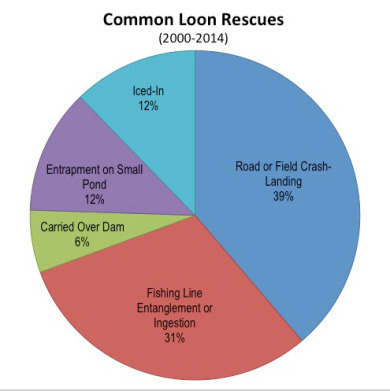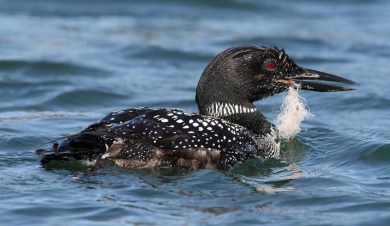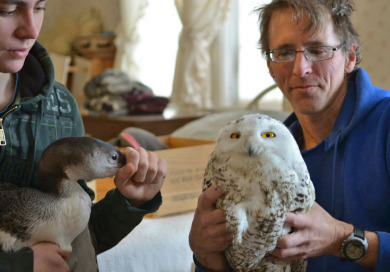With Vermont's nesting Common Loon population relatively low, VCE's rescues of loons in distress are significant in our recovery and conservation efforts. Some of these rescues are routine. Others can be dramatic, which you'll see in some of the rescue stories below.
 Loon rescues make a difference. From 2000-2014, the Vermont Loon Conservation Project, its volunteers, and state game wardens have saved 49 Common Loons. Most of these were adults.
Loon rescues make a difference. From 2000-2014, the Vermont Loon Conservation Project, its volunteers, and state game wardens have saved 49 Common Loons. Most of these were adults.
US Environmental Protection Agency population modeling has shown that each adult loon contributes more to the long-term sustainability of the Common Loon population than the survival of a loon chick. Population modeling has also shown that in Vermont, loon rescues have contributed more to population growth than either nesting rafts or the quiet provided by nest warning signs.
On call and quick in response is our loon biologist, Eric Hanson. Eric can’t save every loon. Catching a free-swimming loon tangled in fishing line or stuck on a small pond from which it cannot fly is not a sure thing. And if a loon has ingested a hook, especially with a lead sinker, the chances of survival are low. The VLCP and volunteers average over 100 hours per summer monitoring and attempting to rescue loons. Here are a few success stories:
A Loon Lands in Metropolis
It’s night and you’re tired from migrating north along the shore of Lake Champlain. Navigating inland, with a a glimmer of still water in view, you decide to set down and rest. But when the sun rises the next morning, you see around you a six-foot embankment, a four-foot iron fence, a Shaw’s grocery store, a Friendly’s Restaurant, a Starbucks, and lots of utility lines overhead.
Not a great place to be if you’re a Common Loon. But that’s exactly what one loon encountered when it landed in a fire department retention pond in Williston’s Taft Corners shopping district in May of 2011.
Over the next few weeks, this loon rose to celebrity status – a media star featured on WCAX-TV and in the Burlington Free Press. With fish in the pond, we gave this loon time to see if it could fly out, despite the short runway, on its own.
But after waiting two months with no loon liftoff, VCE gathered a crew of volunteers, a small boat, spotlights, and a salmon dip net. We do most captures at night to try to confuse the bird; the spotlights allow us to get close with the net.
After considerable effort, we landed the loon and brought it to shore for banding. But Eric soon discovered that its legs were too small for our Vermont leg bands. This was not a result of the loon’s being trapped. Loons are smaller toward the interior of the continent; Eric suspected that this loon was migrating toward nesting grounds in northern Québec.
We transported the loon to the ECHO Lake Aquarium and Science Center dock area in downtown Burlington and released it to big water and a big runway for taking off, presumably for Québec. Bon voyage. Loon project volunteer Gail Osherenko caught the event on video:
Loon Rescue from Shopping Center Storm Water Pond (July 21, 2011) from Gail Osherenko on Vimeo.
A Common Loon Meets a Snowy Owl
On the frigid morning of December 15, 2013, when Rob Strong went in to milk his cows in Craftsbury, Vermont, he came upon a Snowy Owl in his barn. After fluttering around and alarming the cows, the owl made its way out the door. Rob called Eric to the rescue. Eric caught the owl, placed it in a box and brought it home.
A day later, a juvenile Common Loon crash-landed in a field at dusk in Cabot, VT. Lynn Rockwell and her husband first found the bird and called Eric.
That’s when a Common Loon and a Snowy Owl found themselves “sharing a room” in Eric’s home. After completing some work for his winter job (maintaining cross country ski trails), Eric transported the owl to a bird rehabber, Craig Newman, who works for Outreach for Earth Stewardship.
The loon turned out to be in good shape. Eric’s son released the loon into big open water near the Echo Center on Lake Champlain in Burlington, where it swam out a ways, dove, came up, and gave a combination call: part wail, part-yodel.
West Hill Pond (2014)
 When Melissa Perley kayaked up to one of the resident loons on West Hill Pond in Cabot, she noticed it habitually shaking its head in one direction. Fishing line was coming out of its mouth. A Vermont Loon Conservation Project volunteer, Melissa called VCE’s Eric Hanson.
When Melissa Perley kayaked up to one of the resident loons on West Hill Pond in Cabot, she noticed it habitually shaking its head in one direction. Fishing line was coming out of its mouth. A Vermont Loon Conservation Project volunteer, Melissa called VCE’s Eric Hanson.
Eric found the loon to be relatively healthy. When approached, it did a 40-second dive. Eric came back that evening with spotlights and a friend’s small boat with a trolling motor. The bird was surprisingly calm with wail calls playing and a volunteer aiming the spotlight perfectly on the loon’s head. It sat there mesmerized as Eric slipped the dip net into the water and safely landed the loon.
This loon had swallowed a hook or lure and had line and a leader sticking out of its mouth. We pulled as much line out as we could and then cut the leader free, letting the remaining line go down the loon’s throat. Fish hooks will dissolve within a few weeks in these birds’ stomach acids, and we hoped the line would pass through. Loons are surprisingly tough sometimes.

